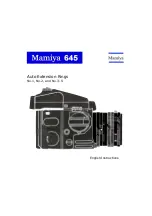
6
Photography with the 90mm refractor
With an optional camera adapter, the 90mm refractor
becomes a 910mm f/10.1 telephoto lens for a single-lens
reflex camera. For long-distance terrestrial or astronomical
photography, you need only a T-ring for your particular cam-
era model. The T-ring attaches to your particular camera
model and threads onto the refractor’s focuser drawtube,
coupling the camera body to the telescope (Figure 3).
Use the camera’s viewfinder to frame the picture. Use the
telescope’s focuser to focus the image. Tighten the focus
lock thumbscrew on the telescope’s focuser to make sure
the camera does not slip out of focus.
You may want to consider using a remote shutter release
instead of the shutter release on the camera. Touching the
camera can vibrate the system and blur the resulting photo-
graphic image. Also, be sure to use a solid tripod.
Care & Maintenance
Give your telescope reasonable care and it will last a life-
time. Store it indoors or in a dry garage. Do not leave the
telescope outside except when using it. The optical tube is
aluminum and has a smooth painted surface that should
resist scratches and smudges. If a scratch does appear
on the tube, it will not harm the telescope. If you wish, you
can apply some white auto touch-up paint to the scratch.
Smudges on the tube can be wiped off with standard house-
hold cleaning fluid.
Any quality optical lens tissue and cleaning fluid specifically
designed for multi-coated optics can be used to clean the
telescope’s objective lens as well as the lenses of the eye-
pieces and finder scope. Never use regular glass cleaner or
cleaning fluid designed for eyeglasses. Before cleaning with
fluid and tissue, blow any loose particles off the lens with
a blower bulb or compressed air, or lightly brush the lens
with a soft camel hair brush. Apply some cleaning fluid to
a tissue, never directly on the optics. Wipe the lens gently
in a circular motion, then remove any excess fluid with a
fresh lens tissue. Oily fingerprints and smudges may be
removed using this method. Use caution; rubbing too hard
may scratch the lens! On larger lenses, clean only a small
area at a time, using a fresh lens tissue on each area. Never
reuse tissues.
Specifications
Objective lens:
Achromatic doublet, air spaced
Objective lens coatings:
Fully coated with multi-coatings
Optical tube:
Seamless aluminum
Aperture:
90mm (3.5”)
Focal length:
910mm
Focal ratio:
f/10.1
Focuser:
Rack-and-pinion, 1.25” accepts
camera T-ring
Optical tube length:
35.5”
Weight of
optical tube assembly:
6lbs. 3oz.
Mounting provision:
Dovetail tube ring mounting
plate, attaches to telescope via
tube rings (included)
Finder scope:
6x magnification, 26mm effective
aperture, achromatic, crosshairs,
provides image orientation same
as the naked eye
Eyepieces:
25mm and 10mm Sirius Plössls,
fully coated with multi-coatings,
1.25” barrel diameter, threaded
for Orion filters
Diagonal:
45° correct-image, 1.25” barrel
diameter

























